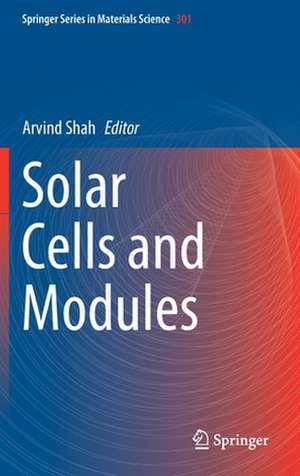Solar Cells and Modules: Springer Series in Materials Science, cartea 301
Editat de Arvind Shahen Limba Engleză Hardback – 17 iul 2020
Din seria Springer Series in Materials Science
- 18%
 Preț: 1820.22 lei
Preț: 1820.22 lei - 18%
 Preț: 776.09 lei
Preț: 776.09 lei - 24%
 Preț: 689.68 lei
Preț: 689.68 lei - 18%
 Preț: 968.96 lei
Preț: 968.96 lei - 20%
 Preț: 568.94 lei
Preț: 568.94 lei - 18%
 Preț: 953.65 lei
Preț: 953.65 lei - 18%
 Preț: 902.36 lei
Preț: 902.36 lei - 18%
 Preț: 953.65 lei
Preț: 953.65 lei - 20%
 Preț: 948.41 lei
Preț: 948.41 lei - 18%
 Preț: 1143.07 lei
Preț: 1143.07 lei - 18%
 Preț: 1111.53 lei
Preț: 1111.53 lei - 18%
 Preț: 1103.62 lei
Preț: 1103.62 lei - 18%
 Preț: 1225.94 lei
Preț: 1225.94 lei -
 Preț: 473.91 lei
Preț: 473.91 lei - 18%
 Preț: 782.42 lei
Preț: 782.42 lei -
 Preț: 433.47 lei
Preț: 433.47 lei - 18%
 Preț: 1116.40 lei
Preț: 1116.40 lei - 18%
 Preț: 723.03 lei
Preț: 723.03 lei - 15%
 Preț: 641.20 lei
Preț: 641.20 lei - 18%
 Preț: 958.56 lei
Preț: 958.56 lei - 18%
 Preț: 1224.36 lei
Preț: 1224.36 lei - 15%
 Preț: 644.82 lei
Preț: 644.82 lei - 24%
 Preț: 833.43 lei
Preț: 833.43 lei - 24%
 Preț: 1060.33 lei
Preț: 1060.33 lei - 18%
 Preț: 964.10 lei
Preț: 964.10 lei - 18%
 Preț: 1224.36 lei
Preț: 1224.36 lei - 18%
 Preț: 1221.20 lei
Preț: 1221.20 lei - 18%
 Preț: 946.87 lei
Preț: 946.87 lei - 18%
 Preț: 1842.31 lei
Preț: 1842.31 lei - 15%
 Preț: 643.34 lei
Preț: 643.34 lei - 18%
 Preț: 1246.32 lei
Preț: 1246.32 lei - 18%
 Preț: 956.81 lei
Preț: 956.81 lei - 18%
 Preț: 953.52 lei
Preț: 953.52 lei - 15%
 Preț: 637.59 lei
Preț: 637.59 lei - 18%
 Preț: 1235.43 lei
Preț: 1235.43 lei
Preț: 953.97 lei
Preț vechi: 1163.38 lei
-18% Nou
Puncte Express: 1431
Preț estimativ în valută:
182.57€ • 188.99$ • 154.31£
182.57€ • 188.99$ • 154.31£
Carte tipărită la comandă
Livrare economică 06-20 martie
Preluare comenzi: 021 569.72.76
Specificații
ISBN-13: 9783030464851
ISBN-10: 3030464857
Ilustrații: XX, 346 p. 225 illus., 176 illus. in color.
Dimensiuni: 155 x 235 mm
Greutate: 0.69 kg
Ediția:1st ed. 2020
Editura: Springer International Publishing
Colecția Springer
Seria Springer Series in Materials Science
Locul publicării:Cham, Switzerland
ISBN-10: 3030464857
Ilustrații: XX, 346 p. 225 illus., 176 illus. in color.
Dimensiuni: 155 x 235 mm
Greutate: 0.69 kg
Ediția:1st ed. 2020
Editura: Springer International Publishing
Colecția Springer
Seria Springer Series in Materials Science
Locul publicării:Cham, Switzerland
Cuprins
Solar Irradiation (and other Illumination Conditions).- Theory of the p-i-n Solar Cell.- Amorphous and Microcrystalline Silicon.- Contact Layers, TCO Layers and Light Trapping.- Thin-Film Silicon Solar Cell Design Options.- Thin-Film Silicon Solar Cell Performance.- Thin-Film Silicon Solar Panels and Modules.- Module Fabrication Issues (Including Encapsulation).- Module Testing: STC and Field Performance.- Application Aspects.- Life Cycle Analysis.
Notă biografică
Arvind Shah was born in Bombay, India, and attended the ETH Zürich, where he graduated in 1964 as Electrical Engineer and completed his PhD in Applied Physics in 1968 on memory applications of ferroelectrics. From 1968 to 1975, he worked as a lecturer and R&D group leader at the Department of Industrial Research of the ETH Zürich and, in 1975, founded and co-directed the Centre for Electronics Design and Technology (CEDT) at the Indian Institute of Science in Bangalore, which is currently one of India’s leading University Centres in the field of electronics. In 1979, he was appointed Professor at the University of Neuchâtel in Switzerland, where he founded the Photovoltaics Research Laboratory (PV Lab Neuchâtel) as a part of the Institute of Microtechnology (IMT). The PV Lab Neuchâtel is a pioneer in the establishment of low-cost production methods for solar cells based on silicon and has significantly contributed to the development of transparent conductive oxides ascontact layers for solar cells.
In October 2005, Arvind Shah retired from his position as Head of the PV Lab and as Professor at the University of Neuchâtel and at the Ecole polytechnique fédérale de Lausanne (EPFL). Since then he has been active as scientific consultant to various industries throughout Europe, India and the USA. He is author or co-author of more than 200 peer-reviewed papers in scientific journals and editor of the book “Thin-Film Silicon Solar Cells”, published by the EPFL Press in 2010. Together with Johannes Meier, he was awarded, in 2005, the Swiss Solar Prize. In 2007 he received the Becquerel Prize, during the 22nd EC Photovoltaic Solar Energy Conference.
Textul de pe ultima copertă
This book gives a comprehensive introduction to the field of photovoltaic (PV) solar cells and modules. In thirteen chapters, it addresses a wide range of topics including the spectrum of light received by PV devices, the basic functioning of a solar cell, and the physical factors limiting the efficiency of solar cells. It places particular emphasis on crystalline silicon solar cells and modules, which constitute today more than 90 % of all modules sold worldwide. Describing in great detail both the manufacturing process and resulting module performance, the book also touches on the newest developments in this sector, such as Tunnel Oxide Passivated Contact (TOPCON) and heterojunction modules, while dedicating a major chapter to general questions of module design and fabrication. Overall, it presents the essential theoretical and practical concepts of PV solar cells and modules in an easy-to-understand manner and discusses current challenges facing the global research and development community.
Caracteristici
Introduces the field in an intuitive and accessible manner Provides an up-to-date survey of research and development of crystalline silicon wafer-based and thin-film solar cells Presents important production techniques and applications of this technology
